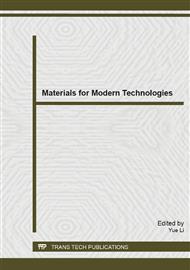p.45
p.51
p.55
p.60
p.66
p.72
p.81
p.89
p.96
Sol-Gel Synthesis and Characterization of Ultrafine ZrSiO4 Powder
Abstract:
High purity ZrSiO4 powder were synthesized using Si (C2H5O)4 and ZrOCl2·8H2O as raw materials by the sol-gel method, LiCl was added as mineralizer to promote crystallization of zircon. The influences of molar ratio of Zr:Si, calcined time and calcined temperature on the synthesis of ZrSiO4 powder were investigated. XRD, SEM and TEM were used to characterize the powders. It was found that when the molar ratio of Zr:Si was 1:1.2, the calcined temperature was 1600°C and the calcined time was 4h, the high purity ZrSiO4 ultrafine powder was obtained. The ZrSiO4 formation began at 1300°C and when the gel was calcined at 1600°Cfor 4 h, the formation rate of ZrSiO4 was up to 95%. SEM and TEM studies reveal a homogeneous product with particle sizes on the order of 0.1-1μm. The IR emissivity of ultrafine ZrSiO4 is 0.892 at the whole wavelength range, and that is up to 0.951 at the wavelength range of 8-14 μm.
Info:
Periodical:
Pages:
66-71
Citation:
Online since:
April 2014
Authors:
Keywords:
Price:
Сopyright:
© 2014 Trans Tech Publications Ltd. All Rights Reserved
Share:
Citation:


